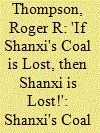|
|
|
Sort Order |
|
|
|
Items / Page
|
|
|
|
|
|
|
| Srl | Item |
| 1 |
ID:
106504


|
|
|
|
|
| Publication |
2011.
|
| Summary/Abstract |
The land-locked north China province of Shanxi, identified in 1870 by the geologist Baron Richthofen as 'one of the most remarkable coal and iron regions in the world', was the site of a provincially-defined national movement far removed from the better-studied treaty ports and their articulate and prolific nationalists. This late-Qing provincialism may be read as a mediating symbol of an emerging national consciousness.
Social tensions were exacerbated by external challenges brought by foreign agents, and their Chinese collaborators, of cultural and economic imperialism. Opposition to missionaries and Chinese Christians had begun as early as the 1860s. In 1898 the British Pekin Syndicate and its extra-provincial Chinese associates, with the backing of the central government, secured rights to Shanxi's rich coal and iron resources. These rights were ceded back ten years later after a successful 'rights-recovery' movement that possesses similarities to (but also significant differences from) the well-studied oppositional movements in Jiangsu, Zhejiang, Hunan, and Shandong in the period 1905-1911. The duration of Shanxi's struggle, along with its extra-bureaucratic elite activism, popular mobilization, and cooperation with Beijing, makes its rights-recovery movement distinctive. The rhetoric and practices of the movement, which began before the Boxer Uprising of 1900 and reflects the rhetorical influence of these earlier protests, contributed to a strong regional solidarity that was backed by central state authority. There were various patterns of protest, one indigenous and provincial, one extra-provincial and nationalist, that interacted in the period 1902-1908. Provincial activists, including merchants, peasants, students, degree-holders, and officials, insisted that Shanxi's coal was for the use of the community, the province, and the nation on terms established by and for the people of Shanxi. In their victory, localism, provincialism, and the national project, had come together.
|
|
|
|
|
|
|
|
|
|
|
|
|
|
|
|
|
|
|
|
|